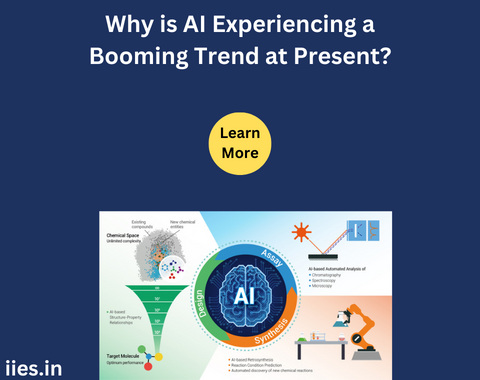
In the contemporary landscape of technological advancements, one phenomenon stands out prominently – the booming trend of Artificial Intelligence (AI).
Over the past decade, AI has transcended its niche status to become a pervasive force influencing various facets of our lives.
From business and healthcare to education and entertainment, the proliferation of AI technologies has been nothing short of revolutionary.
This article delves into the reasons behind the current surge in AI adoption, exploring the factors that contribute to its widespread success and societal impact.
One of the primary drivers behind the booming trend of AI is the exponential growth in technological capabilities. Moore’s Law, which predicts the doubling of processing power approximately every two years, has played a pivotal role in enhancing the performance of AI systems. The increased computational power, coupled with the development of advanced algorithms, has enabled AI models to process vast amounts of data at unprecedented speeds. This, in turn, has elevated the accuracy and efficiency of AI applications, making them more practical and accessible.
Big Data Revolution:
The advent of the digital age has ushered in an era of data abundance, and AI thrives on data. The proliferation of smartphones, social media platforms, and IoT devices has led to an unprecedented generation of data. AI algorithms excel in extracting meaningful insights from massive datasets, allowing businesses and organizations to make informed decisions. The synergy between AI and big data has created a symbiotic relationship, where AI harnesses the power of data to enhance its learning capabilities, and big data benefits from AI’s analytical prowess.
Industry Integration:
AI is no longer confined to research labs or specialized projects; it has become an integral part of various industries. From finance and healthcare to manufacturing and retail, businesses across diverse sectors are incorporating AI technologies to streamline operations, optimize processes, and gain a competitive edge. The realization of AI’s potential to drive innovation and improve efficiency has fueled its widespread adoption across industries, contributing to the current boom.
Rise of Machine Learning:
Machine Learning (ML), a subset of AI, has emerged as a game-changer in the field. ML algorithms enable systems to learn and improve from experience without explicit programming, making them adaptable to changing scenarios. This ability to learn from data has propelled ML into various applications, including image and speech recognition, natural language processing, and predictive analytics. As ML algorithms become more sophisticated, their applicability in real-world scenarios expands, further contributing to the surge in AI adoption.
Increased Investment and Funding:
The surge in AI’s popularity is closely linked to the influx of investments and funding in the AI ecosystem. Governments, corporations, and venture capitalists recognize the transformative potential of AI and are actively investing in research, development, and implementation. This financial support has fueled innovation, accelerated the deployment of AI technologies, and paved the way for startups and established players to contribute to the burgeoning AI landscape.
Enhanced User Experience:
AI has become synonymous with providing enhanced user experiences across various applications. From personalized recommendations on streaming platforms to virtual assistants anticipating user needs, AI has redefined how individuals interact with technology. The integration of AI-driven features enhances convenience, efficiency, and satisfaction, creating a positive feedback loop that fosters further adoption.
Accessibility of Cloud Computing:
The accessibility of cloud computing has significantly contributed to the democratization of AI. Cloud platforms offer scalable computing resources, enabling businesses of all sizes to leverage powerful AI capabilities without the need for substantial infrastructure investments. This accessibility has lowered entry barriers, allowing a broader spectrum of organizations to harness the benefits of AI technologies.
Evolution of Natural Language Processing:
Advancements in Natural Language Processing (NLP) have played a pivotal role in making AI more human-centric. This evolution has led to the development of conversational AI, chatbots, and virtual assistants that can comprehend and respond to human queries, enhancing the overall user experience.
Ethical and Regulatory Frameworks:
As AI applications become more pervasive, concerns about ethics, bias, and privacy have gained prominence. This has led to the development of ethical guidelines and regulatory frameworks to ensure responsible AI deployment. Governments and industry stakeholders are actively working on establishing standards to address ethical considerations, instilling confidence in users and fostering a more sustainable AI ecosystem.
COVID-19 Acceleration:
The global COVID-19 pandemic has acted as a catalyst for the accelerated adoption of AI in various domains. The need for contactless solutions, remote collaboration, and data-driven decision-making during the pandemic underscored the value of AI technologies. From healthcare solutions like diagnostic tools to optimizing supply chain management, AI proved instrumental in addressing challenges posed by the pandemic, further boosting its relevance and adoption.
The current booming trend of AI is the result of a confluence of factors, including technological advancements, the big data revolution, industry integration, increased investment, and enhanced user experiences. As AI continues to evolve, its impact on society will only intensify. However, it is crucial to navigate the ethical and regulatory challenges associated with AI to ensure its responsible and sustainable integration into our lives. The future promises even more transformative applications of AI, and as the journey unfolds, it is imperative to strike a balance between innovation and ethical considerations for a harmonious coexistence with artificial intelligence.
Indian Institute of Embedded Systems – IIES